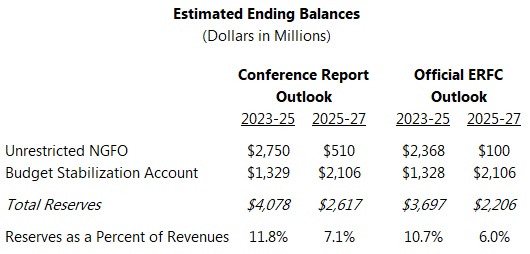10:21 am
April 26, 2024
Yesterday the Economic and Revenue Forecast Council (ERFC) approved an official budget outlook based on the 2024 supplemental operating budget. The unrestricted ending balance in funds subject to the outlook (NGFO) is significantly smaller for both the current and next biennium than had been estimated when the budget was passed by the Legislature. This means that total reserves are now expected to be lower.
The 2024 supplemental budget still balances over four years, but the unrestricted NGFO ending balance at the end of the second biennium is now estimated to be $100 million. It was $510 million in the estimated outlook that accompanied the conference report for the supplemental.

The difference is mainly due to a change in the assumptions about reversions. Reversions are appropriations that aren’t ultimately spent. Generally, the outlook assumes that reversions will be 0.5% of general fund–state (GFS) appropriations. (On top of that, there are also reversions related to K–3 class size requirements.) The 0.5% assumption is based on historical reversions, but, as I wrote here, reversions have been unusually high in recent years.
Consequently, the conference report outlook assumed that reversions would be 1.2% of GFS appropriations in FY 2024 and FY 2025, and then drop back to 0.5% starting in FY 2026. For the official outlook, the ERFC decided to assume that reversions will be 0.8% of GFS appropriations for FY 2024 and 0.5% beginning in FY 2025. This change reduces assumed reversions by $378 million in 2023–25. (In other words, the official outlook assumes the state will spend $378 million more of the appropriated funds than previously assumed.)
Other assumptions changes in the official outlook include:
- NGFO appropriations in the second biennium increase by $30 million because the official outlook (unlike the conference outlook) does not assume federal Medicaid matching funds for Olympic Heritage Behavioral Health in FY 2027.
- NGFO appropriations in the second biennium decrease by $11.5 million because the official outlook (unlike the conference outlook) does not assume that basic foster care rates will be adopted next year.
Finally, the official outlook incorporates the effects of the governor’s vetoes, but they were modest and only reduce appropriations by $2 million in 2023–25 (they have no impact in 2025–27).
Altogether, the unrestricted NGFO ending balance in the official outlook is $382 million lower in 2023–25 and $410 million lower in 2025–27 than had been assumed in the conference report outlook.
The $100 million ending balance in the second biennium is not an unusual level, but the change from the conference report outlook to the official outlook is fairly unusual, as the chart below shows.

Tags: 2024 supp
